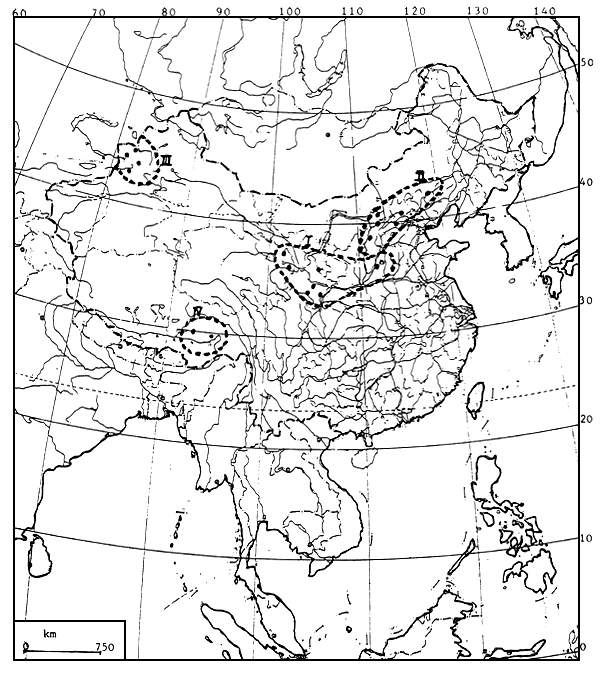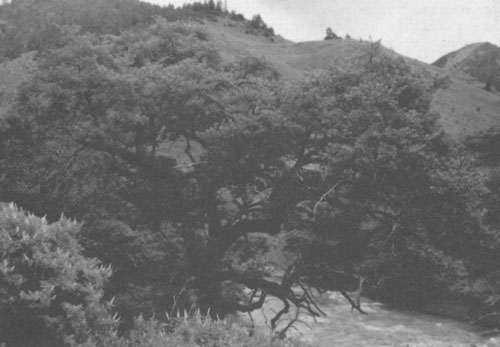by
Zhao Hanzhang1
The Research Institute of Forestry
Chinese Academy of Forestry
Wan Shou Shan
Beijing 100091
China
INTRODUCTION
Hippophae rhamnoides (sea buckthorn) is a shrub or small tree which is tolerant both of drought and cold. It provides land stabilization/ amelioration, fuel, food (fruits are very rich in vitamin C), medicine (bark) and fodder to rural communities living in harsh environmental conditions in China. Like all the species of the family Elaeagnaceae, Hippophae rhamnoides is a nitrogen fixing species thanks to its symbiosis with Frankia bacteria, housed in root nodules.
Hippophae rhamnoides is a dioecious species distributed widely in Asia and Europe (2–115° longitude, 27–68°50 north latitude). In China it occurs naturally mainly in the provinces of Inner Mongolia, Hebei, Liaoning, Shanxi, Gansu, Ningxia, Qinghai, Xinjiang, Tibet, Sichuan and Yunnan. The total area of Hippophae rhamnoides in China is about 920 000 ha of which 80% are natural stands (Wang Guoli & Zhong 1990).
Recognizing the importance of this multipurpose tree species, a FAO technical assistance programme was initiated in China in the late 1980's with financial support from the Government of France. This was the first systematic approach to explore, sample and test Hippophae sp. in China. The objectives of the programme were the following:
During the past five years the below results were achieved.
SEED COLLECTIONS IN HIPPOPHAE RHAMNOIDES
Seed was collected from 19 sites throughout the natural range in China (see Table 1 and Figure 1). Collections were well documented and were made from a minimum of 20 mother trees, spaced at. least 50 m apart to minimize relateness and future inbreeding. Seed from 19 provenances were sampled.
Table 1: Seed collection of Hippophae rhamnoides in China
| Location | North Latitude | East Longitude | Elevation (m) |
|---|---|---|---|
| Lin Zhi, Tibet | 29°35' | 94°10' | 3700 |
| Mozhugongka, Tibet | 29°52' | 92°01' | 3900 |
| Tianshui, Gansu | 34°20' | 105°48' | 1700 |
| Wushan, Gansu | 34°45' | 104°56' | 2000 |
| Qinan, Gansu | 35°01' | 106°13' | 1900 |
| Xiji, Ningxia | 35°57' | 105°48' | 2200 |
| Hualong, Qinghai | 36°03' | 102°12' | 2700 |
| Guxian, Shanxi | 36°35' | 111°40' | 1100 |
| Datong, Qinghai | 37°10' | 100°50' | 2800 |
| Kelan, Shanxi | 39°02' | 111°30' | 1700 |
| Weixian, Hebei | 39°55' | 114°30' | 1600 |
| Youyu, Shanxi | 40°10' | 112°35' | 1360 |
| Liangcheng, Inner Mongolia | 40°20' | 112°15' | 1250 |
| Zhuolu, Hebei | 40°25' | 115°15' | 1300 |
| Chifeng, Inner Mongolia | 40°20' | 118°56' | 1400 |
| Gongliu, Xinjiang | 43°25' | 82°02' | 775 |
| Nileke, Xinjiang | 43°50' | 82°30' | 1105 |
| Chabuchaer, Xinjiang | 43°52' | 81°05' | 600 |
| Bole, Xinjiang | 44°54' | 82°02' | 750 |
Figure 1: Map of the 19 provenances of H. rhamnoides collected in China, divided into 4 groups

FIELD EVALUATION
The seedlots were sown in nurseries and observations were made on seed characteristics, germination and seedling traits. In 1986, field trials were established on 15 sites in 11 provinces of China (see Table 2). A randomised complete block design with 4 replications was used, with 36 plants per plot, spaced 3×3 m or 2×4 m. In 1988, floods and droughts had occurred frequently in some of the provinces of China and a total of 6 planting sites suffered serious damage. In the remaining 9 experimental sites, the survival rate of seedlings was over 90 %.
Table 2: Locations of field evaluation of Hippophae rhamnoides
| Location | North Latitude | East Longitude | Elevation | Annual Mean Temp. | Annual Rainfall |
| (m) | (°C) | (mm) | |||
| Tianshi, Gansu | 34°20' | 105°48' | 1250 | 11.0 | 550 |
| Datong, Qinghai | 36°56' | 101°41' | 2400 | 3.9 | 533 |
| Guxian, Shanxi | 36°35' | 111°40' | 1100 | 9.0 | 600 |
| Youyu, Shanxi | 40°10' | 112°35' | 1400 | 3.6 | 449 |
| Zhuolo, Hebei | 40°25' | 115°15' | 1200 | 5.3 | 500 |
| Jianping, Lioning | 41°23' | 119°40' | 750 | 5.6 | 400 |
| Chifeng, Inner Mongolia | 42°20' | 118°58' | 570 | 4.6 | 350 |
| Yining, Xinjiang | 43°57' | 81°31' | 663 | 8.5 | 246 |
| Duerbete, Heilongjiang | 46°50' | 124°26' | 145 | 0.9 | 385 |
RESULTS
A preliminary assessment of the field trials has yielded some indicative results. Significant differences among the provenances were evident. This could maybe have been predicted by the fact that the occurrences of Hippophae rhamnoides are widely dispersed and, to a certain extent, completely isolated from each other (Rousi 1971).
Generally, the hight of the seedlings was found to be positively correlated with latitude. The provenances from Qinghai, Gansu province and Ninxia Hui Autonomous Region located in mid latitude and high elevation areas, showed superiority in growth in the nursery and the field, and also had more branches and better coppicing ability. Not surprisingly, the weight of the root nodules per plant was found to relate closely to the above-ground biomass of the plant.
The ratio of female trees in the trials was 50%. Fruit size was significantly and positively correlated with latitude and negatively correlated with elevation. The provenances located in the northern part of China had bigger and earlier-maturing fruits than those found in provenances from the central-western area. There was also significant variation in the biochemical composition of the fruits from different provenances. Vitamin C and acid content were negatively correlated to latitude, while sugar content was positively correlated (see Table 3).
Table 3: Biochemical composition of fruit of different provenances.
| Provenances | Vitamin C | Total sugar | Total acid | Total Oil |
| (mg/100g) | (%) | (%) | (%) | |
| Mean | Mean | Mean | Mean | |
| Tianshui, Gansu | 1337.3 | 2.38 | 3.55 | 9.88 |
| Wushan, Gansu | 1675.2 | 2.52 | 4.51 | 7.08 |
| Qinan, Gansu | 1932.3 | 3.36 | 3.60 | 9.54 |
| Xiji, Ningxia | 1051 | 3.04 | 3.75 | 10.89 |
| Hualong, Qinghai | 822.2 | 4.60 | 3.36 | 5.43 |
| Guxian, Shanxi | 976.7 | 3.44 | 3.58 | 5.68 |
| Datong, Qinghai | 337.0 | 5.49 | 3.56 | 10.22 |
| Kelan, Shanxi | 861.7 | 4.50 | 1.97 | 11.44 |
| Weixian, Hebei | 614.3 | 4.74 | 2.60 | 19.27 |
| Youyu, Shanxi | 208.0 | 5.93 | 1.93 | 6.75 |
| Liangcheng, Inner Mongolia | 487.9 | 4.60 | 2.27 | 13.25 |
| Zhuolu Hebei | 765.2 | 3.90 | 2.36 | 5.51 |
| Chifeng, Inner Mongolia | 306.7 | 5.14 | 2.18 | 12.22 |
The 19 provenances could be divided in 4 different groups2 (see Figure 1):
The Central-Western group. This contains the best growing provenances. The fruits contain a large amount of vitamin C, and ripen late in the year. The group includes 3 provenances from Gansu province, 2 from Qinghai province and 1 from southern Shaxi province.
Northern group. Of medium growth. The fruits are relative large, have higher sugar content and ripen early in the year. The group includes 2 provenances from Hebei Province, 2 from the northen part of Shaxi province and 2 from the Inner Mongolia Autonomous Region.
Xinjiang group. Poor growth. Most of the trees in the experiments died. The group includes 4 provenances from the Xinjiang Uygur Autonomous Region.
Tibet group. Poor growth. The group includes 2 provenances from the Tibet Autonomous Region. Within 10 days after planting, most of the seedlings died of damping-off or other reasons.
REFERENCES
Guoli, W. & Zhong, Z. 1990 Research and production of sea buckthorn in China. Voluntary Contribution to World Forestry Congress, Paris, France. 5 pp. (E)
Rousi, A. 1971 The genus Hippophae L. A taxonomic study. Ann. Bot. Fennici 8: 177–227

Figure 2: Hippophae rhamnoides subsp. yunnanensis in China
1 Manuscript received March 1992.